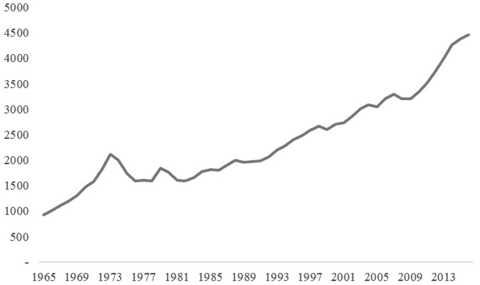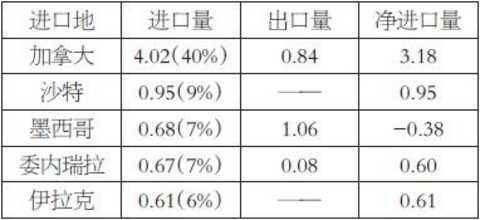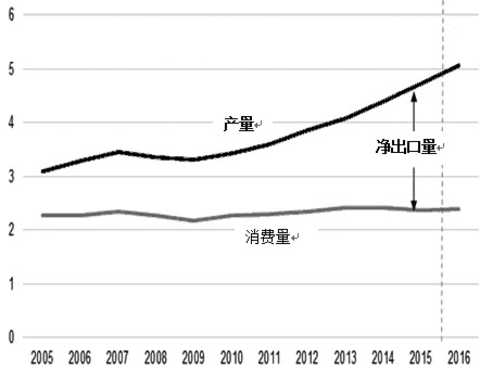The development of the Canadian crude oil industry still has a stumbling block
Known as the “Maple Leaf Countryâ€, Canada is rich in oil and gas resources and is one of the top five energy producers in the world and the largest crude oil supplier in the United States. In 2016, the country's proven crude oil reserves were 171.5 billion barrels, accounting for one-tenth of the world's total reserves.
Canadian crude oil was originally formed in the western part of the continental plate. Due to the subduction pressure of the Pacific plate, the permeable sandstone body shifted eastward, forming Alberta, Canada's most important crude oil producing area. The Cretaceous sandstone bodies where these oil and gas are located rise, and after oxidation, water washing and biodegradation, oil sands with high viscosity and high impurity are finally formed.
More than 97% of the crude oil resources in Canada are oil sands, mainly distributed in the Western Canadian Sedimentary Basin (WCSB) and offshore areas of the Atlantic Ocean. Oil sands production accounts for more than half of Canada's total crude oil production, and Alberta's production accounts for 78% of the country's total crude oil production, of which 81% comes from oil sands resources. In addition, Saskatchewan's crude oil production accounts for 15% of the country's total crude oil production due to its location in the Western Canadian sedimentary basin and near the Atlantic Ocean.
Alberta oil sands are concentrated in three regions, with the largest reserves being the Athabasaca mining area, followed by the Cold Lake mining area and finally the Peace River mining area (Peace River).
According to the 2017 BP yearbook data, the daily production of Canadian crude oil in 2016 was 4.46 million barrels. Although the oil price has plummeted since 2014, the crude oil market has experienced low oil prices for three consecutive years, and oil companies have cut spending to support the industry's winter, but Canadian crude oil The overall output is on the rise. According to Bloomberg data, in April 2018, the country's crude oil output was 4.3 million barrels per day, of which light crude oil produced 2.3 million barrels per day and heavy crude oil produced 2 million barrels per day. Crude oil production in the Alberta region accounts for 46% of total crude oil production in western Canada. In April 2018, the number of oil and gas wellheads in Canada was 617, of which Alberta had 422, accounting for 68%. Since Canadian crude oil production is dominated by western producing areas, this article focuses on the situation in this producing area.

The picture shows Canadian crude oil production (unit: thousand barrels / day)
As the efficiency of crude oil drilling increases, drilling costs continue to decline. According to data from the Canadian Petroleum Service Association (PSAC), the cost of drilling and completion in sedimentary rock formations decreased by 6% year-on-year at the end of 2017, and the cost of casings decreased by 22%. There are two main ways to develop oil sands in Canada: one is open-pit mining, that is, oil sand resources with a depth of less than 75 meters, excavated directly from the surface with forklifts and trucks; the other is in-situ mining. In situ, drilling and mining oil sand resources buried between 75 and 1000 meters. According to the Canadian Petroleum Institute (CAPP), only 19% of Canadian oil sands resources are suitable for open pit mining, and most require drilling. According to the American Economic Association (AER), in 2016, a project that used open-pit mining of 100,000 barrels of crude oil per day costed between 9 billion and 11 billion Canadian dollars, and the average cost per barrel of crude oil was 65-80 dollars. If in-situ mining technology is used, the use of steam-assisted gravity drainage (SAGD), a project that produces 30,000 barrels of crude oil per day, costs only 750 million to 1.35 billion Canadian dollars, and the average cost per barrel is 30-50 dollars. It takes a lot of time to exploit oil sand resources in open pit, and it takes a long time to invest in the early stage. However, the in-situ mining technology uses less capital cost in the early stage and can gradually increase capital.
According to CAPP calculation, in 2016, the daily output of oil sands in western Canada was 2.4 million barrels, of which 1.03 million barrels were open-pit mining and 1.37 million barrels were in-situ mining. It is estimated that by 2030, the daily output of oil sands can reach 3.67 million barrels, of which open air The mining was 1.51 million barrels and the in-situ mining was 2.16 million barrels. In the future, with the further improvement of production efficiency of in-situ mining technology, its output ratio will be higher than open-pit mining. In 2016, affected by the Fort Mcmurray fire, Canadian oil sands production declined, but the agency predicts that Canada's crude oil production growth will remain very optimistic in the future.

Table shows Canadian oil sands production forecast (unit: million barrels / day)
B Demand and consumption
In recent years, the supply pattern of the North American crude oil market has undergone tremendous changes. The rise of shale oil has caused a sharp increase in the production of light crude oil. In 2015, the United States lifted the ban on crude oil exports, and US crude oil can be directly exported to foreign countries. Despite this, Canada is still the most important importer of crude oil in the United States, and the US refinery is upgraded to facilitate the processing of cheap Canadian heavy crude oil. From the structure of crude oil processed by American refineries, half of the raw materials come from China, and the rest need to import crude oil produced in Canada, Saudi Arabia, Venezuela and other countries. According to the US Energy Information Administration (EIA) data, in 2017, Canada was the most important source of crude oil imports from the United States. US imports of Canadian crude oil accounted for 40% of its total imports, reaching 4.02 million barrels per day, while the United States exported to Canada. The crude oil is only 840,000 barrels per day, and the United States imports 3.18 million barrels of crude oil per day from Canada.
Canadian refineries are concentrated in three regions: Alberta, Saskatchewan in the west, Ontario, Quebec in the east, and the Atlantic coast. Refineries in Western Canada and Ontario all process Canadian crude oil; Québec and Atlantic refineries are mainly processed from crude oil imported from the United States, Central and South America. Western Canada is dominated by agriculture, tourism and energy development. The demand for crude oil is limited. The existing 8 refineries can process 683,000 barrels of crude oil per day. The eastern part is Canada's industrial hub with eight refineries on Ontario, Quebec and the Atlantic coast, processing 1.2 million barrels of crude oil a day. The total processing capacity of crude oil in 17 refineries nationwide is 1.907 million barrels per day.

The table shows the top five countries in the United States importing crude oil (unit: million barrels / day)
Overall, Canadian refinery demand is less than half of domestic production, and the United States is Canada's main crude oil exporter. The Midwestern United States (PADDII) is the main force of Canadian crude oil demand, relying on imports of crude oil from western Canada. The daily processing capacity of refineries in the region is 4 million barrels, of which 2.2 million barrels are imported, accounting for 98% of the total imports. Meet 60% of the local refinery's refining needs. Since 2012, the US Midwest refinery has increased capital investment, and the upgrading of the equipment has improved the processing capacity of heavy crude oil.

The picture shows the consumption of Canadian crude oil (unit: thousand barrels / day)
C pipe transportation
Canadian oil products rely mainly on pipeline transportation. In addition to being connected to the west coast of Canada and the eastern coast, the pipeline is also connected to its largest crude oil demand – the Midwestern United States and the Gulf of Mexico (PADDIII). Although the oil pipeline facilities are complete, they still cannot meet the needs of domestic and American refineries. Therefore, railway transportation is needed to make up for the shortage of pipeline capacity.
Main oil pipeline
Canada's pipeline flow can be divided into four main lines, namely Enbridge Mainline, Trans Mountain, Enbridge Express and TransCanada Keystone. The Western Canada pipeline mainly supplies crude oil produced in Alberta and Saskatchewan, with a nominal capacity of 4 million barrels per day, and the actual available capacity is only 3.3 million barrels per day. At present, the pipeline capacity in the region is full, and the railway transportation capacity exceeds 100,000 barrels per day. If the progress of new pipelines is slow, the rail transport activities will increase. With the addition of four new pipelines – Enbridge Line 3, Kinder Morgan's Trans Mountain Expansion, TransCanada's Keystone XL and TransCanada Energy East – the capacity will increase by 2.89 million barrels per day.
Specifically, the Enbridge Mainline pipeline consists of a number of pipelines that transport Western Canada and the US Montana and North Dakota oils to the Western Canadian refinery and the Midwestern United States, which has a daily capacity of 2.85 million barrels. In addition, the Enbridge pipeline is connected to multiple pipelines in the United States, such as the Line 9 pipeline in Sarnia, the Minnesota pipeline in Clearbrook, and the Spearhead South pipeline in Flanagan. Due to the lack of capacity of the Mainline pipeline, refinery demand cannot be met, and producers can only choose rail transportation with higher costs.
The Trans Mountain pipeline from Kinder Morgan's refinery is the only route connecting Canada's western coast. The pipeline, from Edmonton, Alberta, transports oil to the third largest city in Canada, British Columbia, and direct access to the Westridge Marine Terminal. In this way, Canadian crude oil can be transported to the US Gulf of Mexico and the ocean to Asia via a marine tanker. The current pipeline capacity is 300,000 barrels per day.
The Enbridge Express pipeline has a capacity of 280,000 barrels per day and is primarily connected to the Canadian and American Rocky Mountains (PADDIV) and Midwest (PADDII) regions, which extend from Alberta's Hardisty to Wyoming, USA. Casper is connected to the Platte pipeline. The Platte pipeline from Casper to Guernsey can carry 164,000 barrels per day of crude oil, with a capacity of 145,000 barrels per day from Guernsey to the Wood River in Illinois.
The TransCanada Keystone pipeline supplies Canadian crude oil primarily to the Midwest and Gulf of Mexico. The pipeline leads from Hardisty, Alberta, to the center of Steele City, Nebraska, and oil is transported eastward to Wood. The river and Patoka can also be transported to Cushing, Oklahoma's delivery, and the oil will be shipped to refinery sites along the Gulf Coast.
In terms of new pipeline construction, the Enbridge Mainline Line 3 pipeline project has increased capacity by 390,000 barrels per day, and the capacity increase after the expansion of the Line 3 pipeline totaled 760,000 barrels per day. In addition to the Line 3 pipeline, the Enbridge Mainline pipeline has a daily capacity of 2.45 million barrels and consists of Line 5, Line 6, Line 14, and Southern Access pipelines, which are closely linked to other pipelines, allowing Mainline to connect to the Midwest and Central Canada.
The Trans Mountain pipeline expansion plan will increase shipments from Burnaby to the Asian market, from an average of 10 tankers per month to 25-30 tankers. At the same time, a new 1,150-kilometer parallel oil pipe will be built, passing through Edmonton, Alberta, through the interior of British Columbia, and arriving at Burnaby through Abbotsford in the Fraser Valley.
Pipeline capacity bottleneck highlights
According to the monitoring of the well-known consultancy Genscape, the excess capacity of pipelines in western Canada in 2016 was 240,000 barrels per day, and fell to 140,000 barrels per day in the first half of 2017. In August last year, Genscape monitoring showed that with the increasing production of crude oil in Canada, the pipeline capacity was running at full capacity, and the pipeline capacity was less than 90,000 barrels per day by the end of the year. Later, the keystone pipeline was closed due to leakage, which aggravated the bottleneck problem of pipeline capacity.
Since the launch of the Western Canadian Select Crude Oil (WCS) Heavy Oil Price Index in 2016, it has replaced the crude oil trade pricing method based on the “WTI Light Crude Oil Base Price + Difference Priceâ€. Since the end of last year, the WCS spot price has been heavily discounted to the US Cushing crude oil price, mainly due to the closure of the keystone pipeline for two weeks, and there have been many derailments in the domestic railway. The Canadian railway is usually mainly for food, and the railway company is worried about the crude oil producer. The increase in demand for railways is only temporary, so the railway company is reluctant to expand its transportation capacity and take the opportunity to raise the freight rate unless the manufacturer signs a long-term contract with the railway company, causing the Canadian WCS crude oil to expand, which was once in February this year. Post Reservoir Xin crude oil over 30 US dollars / barrel.
According to data from the Energy Canada (NEB), when the price of the WCS paste reservoir is $15/barrel, Canada's heavy crude oil demand – the Midwestern United States imports 1.8 million barrels of Canadian heavy oil per day. With a discount of $15, a month's refinery's raw material costs can be saved by $1 billion (US$800 million). Like the Pine Bend refinery in Minnesota, processing Canadian heavy crude oil accounts for 80% of the refinery's daily processing capacity. Take advantage of WCS's opportunity to sneak into the reservoir and earn about $2 billion a year.
Genscape expects Canada's pipeline capacity to expand by 340,000 barrels per day by the end of 2018, which needs to be achieved through new pipelines. From the perspective of the new pipeline, the capacity of the Enbridge Line 3 pipeline, which has been mainly transporting heavy crude oil, will be expanded from 390,000 barrels to 750,000 barrels per day. At present, the Minnesota state government has delayed approval. Line 3 construction is complicated and controversial. The state government is worried that it may adversely affect the living environment of local residents. Therefore, the possibility of the Enbridge Line 3 pipeline originally scheduled to be opened in early 2019 is not working as scheduled. Large, this means that the situation of WCS in the next two years will continue, and the demand for railway transportation will continue to increase.
Last year, CAPP raised its forecast for Canadian crude oil production. By 2030, crude oil production will reach 5.1 million barrels per day. The 53% increase will benefit from the expectation of oil sands production increase. At that time, oil sand production will increase to 3.7 million barrels per day. The year is only 2.4 million barrels per day. In the context of the expected increase in oil sands in Canada, if new pipelines fail to be delivered as scheduled, then crude oil producers can only be transported by rail. Last year, the total capacity of crude oil transported by Western Canada Railway was 754,000 barrels per day. In fact, the capacity of western railways in 2016 was 100,000 barrels per day, and it increased to 140,000 barrels per day in the first quarter of 2017. Investment bank JP Morgan expects Canada's railway capacity to increase to 334,000 barrels and 384,000 barrels per day this year and next. If the new pipeline is delayed in 2020, the dependence on the railway will continue to increase.
D summary
Normally, as Canada's oil sands production efficiency continues to increase, the country's crude oil production will continue to increase production. Although Canada will build four new oil pipelines, it will increase capacity. However, due to the strictening of local government approval policies and local people's concerns about environmental protection, the new pipeline deployment plan may not be carried out as scheduled.
At present, the oil pipeline is operating at full capacity, and crude oil producers only have to choose more expensive railway transportation to make up for the shortage of pipeline capacity. In the medium and long term, it will restrict the growth rate of production in the country and become a stumbling block in the development of the crude oil industry. Recently, although the Canadian WCS crude oil paste reservoir price has shrunk to 16 US dollars / barrel, compared with the new high of 30 US dollars / barrel in February this year, the producers are still forced to slow down the crude oil production activities, or arrange oil field maintenance in advance to deal with The problem of profit erosion.
Fashion Clothing,Fashion Men'S Jacket,Hanging Dye Men'S Sportswear,Custom Oversized Hoodie Sweatshirt
Shaoxing Weihui International Trade Co.,Ltd. , https://www.weihui-fabric.com